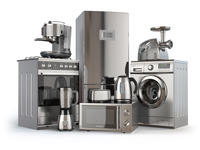Home appliances exporting is the process of selling and shipping domestic appliances, such as refrigerators, washing machines, air conditioners, ovens, and other electronic devices, to foreign markets. It involves the production, packaging, transportation, and delivery of these appliances to customers in different countries.
Exporting home appliances can be a lucrative business for manufacturers and suppliers. It allows companies to expand their customer base beyond their domestic market and tap into the global demand for household appliances.
Several factors contribute to the growth of home appliances exporting
1. Global Demand: The demand for home appliances exists worldwide, as households in various countries require these products for their daily needs. Rising standards of living, urbanization, and increased disposable income in emerging markets have fueled the demand for modern appliances.
2. Competitive Advantage: Many countries have a competitive advantage in manufacturing home appliances due to factors such as lower production costs, skilled labor, and advanced technology. These advantages help them produce appliances at a lower cost, making them attractive for export.
3. Trade Liberalization: The reduction of trade barriers, such as tariffs and quotas, through international trade agreements has facilitated the export of home appliances. Free trade agreements and regional economic blocs have opened up new markets and simplified the export process for manufacturers.
4. Technological Advancements: Technological advancements in the home appliances industry have led to the development of innovative and energy-efficient products. These features appeal to consumers globally and create opportunities for exporters to meet the demand for more advanced appliances.
5. Brand Recognition: Established brands with a reputation for quality and reliability have an advantage in the export market. Consumers often prefer well-known brands when purchasing home appliances, leading to increased export opportunities for recognized manufacturers.

Exporting home appliances involves several steps. Manufacturers need to ensure product compliance with international standards, adapt to local regulations and consumer preferences, establish distribution networks, and handle logistics and shipping. They may also need to provide after-sales service and warranties to maintain customer satisfaction and loyalty.
Exporters can utilize various channels to reach international customers, such as direct sales through their own distribution networks or partnering with local distributors and retailers. Online platforms and e-commerce have also become popular for reaching global consumers directly.
However, exporters should be aware of potential challenges in home appliances exporting. These include fluctuating exchange rates, trade barriers, cultural differences, logistics complexities, and intense competition in the global market.
Overall, home appliances exporting offers significant opportunities for manufacturers to expand their business and reach a broader customer base. It contributes to economic growth, job creation, and technological development while meeting the demand for modern household appliances worldwide.
The rules and regulations
The rules and regulations governing home appliances exporting can vary from country to country and often depend on the specific product being exported. However, here are some general rules that exporters typically need to consider:
1. Compliance with Product Standards: Exporters must ensure that their home appliances meet the applicable product safety and quality standards of the target market. These standards may include electrical safety, energy efficiency, electromagnetic compatibility, and environmental requirements. Compliance is usually demonstrated through testing, certification, and labeling processes.
2. Export Documentation: Exporters need to prepare and submit various documents to comply with export regulations. These documents may include commercial invoices, packing lists, certificates of origin, export licenses (if required), and any specific documentation requested by the importing country.
3. Customs Procedures: Exporters must comply with customs procedures and requirements, including proper classification and valuation of the exported appliances, completion of customs declarations, and payment of any applicable duties, taxes, or fees. Exporters may need to work with customs brokers or freight forwarders to ensure smooth customs clearance.
4. Trade Barriers and Tariffs: Exporters need to be aware of any trade barriers, such as import quotas or restrictions, imposed by the target market. They should also consider the tariffs or customs duties that may be applied to their products. Free trade agreements or preferential trade arrangements between countries can sometimes provide tariff reductions or exemptions.
5. Intellectual Property Rights: Exporters should take measures to protect their intellectual property (IP) rights when exporting home appliances. This includes registering trademarks, patents, or designs in the target markets and ensuring that their products do not infringe upon the IP rights of others.
6. Packaging and Labeling Requirements: Exporters need to comply with packaging and labeling regulations of the importing country. This may include requirements for product labeling, language translations, safety warnings, and packaging materials that meet environmental standards.
7. Documentation of Origin: Exporters may need to provide a certificate of origin to prove the origin of their products. This document establishes whether the appliances qualify for any preferential treatment under trade agreements or if they are subject to specific import regulations.
8. After-sales Service and Warranty: Exporters should consider providing after-sales service and warranty support to customers in the target market. This may involve establishing service centers or partnering with local service providers to ensure customer satisfaction and comply with local consumer protection laws.
It's important for exporters to conduct thorough research and seek guidance from trade associations, export promotion agencies, or legal professionals to understand the specific rules and regulations that apply to their home appliances exporting activities in each target market.

A wide range of home appliances
A wide range of home appliances can be exported to international markets. Here are some examples of appliances that are commonly exported:
1. Refrigerators: Both single-door and multi-door refrigerators, including those with advanced features like frost-free technology and energy efficiency, are popular for export.
2. Washing Machines: Front-loading and top-loading washing machines, as well as washer-dryer combos, are commonly exported appliances.
3. Air Conditioners: Window air conditioners, split air conditioners, and portable air conditioners are exported to meet the demand for cooling solutions in different climates.
4. Ovens and Cooktops: Electric and gas ovens, stoves, cooktops, and ranges are exported to provide cooking solutions for households worldwide.
5. Dishwashers: Dishwashers are exported to offer convenience and efficient dish cleaning to consumers in various countries.
6. Microwaves: Countertop and built-in microwaves are popular appliances that are exported for their versatility and time-saving cooking capabilities.
7. Small Kitchen Appliances: Exported small kitchen appliances include blenders, juicers, toasters, coffee makers, food processors, and electric kettles.
8. Vacuum Cleaners: Upright vacuums, canister vacuums, robotic vacuums, and handheld vacuums are exported to cater to the cleaning needs of households.
9. Water Heaters: Gas and electric water heaters, including tankless or instant water heaters, are commonly exported appliances.
10. Home Comfort Appliances: Exported home comfort appliances include fans, heaters, dehumidifiers, and air purifiers.
It's important to note that the specific appliances exported may vary depending on factors such as market demand, consumer preferences, and regulations in the target countries. Manufacturers and exporters often adapt their product offerings to meet the specific requirements of different markets.